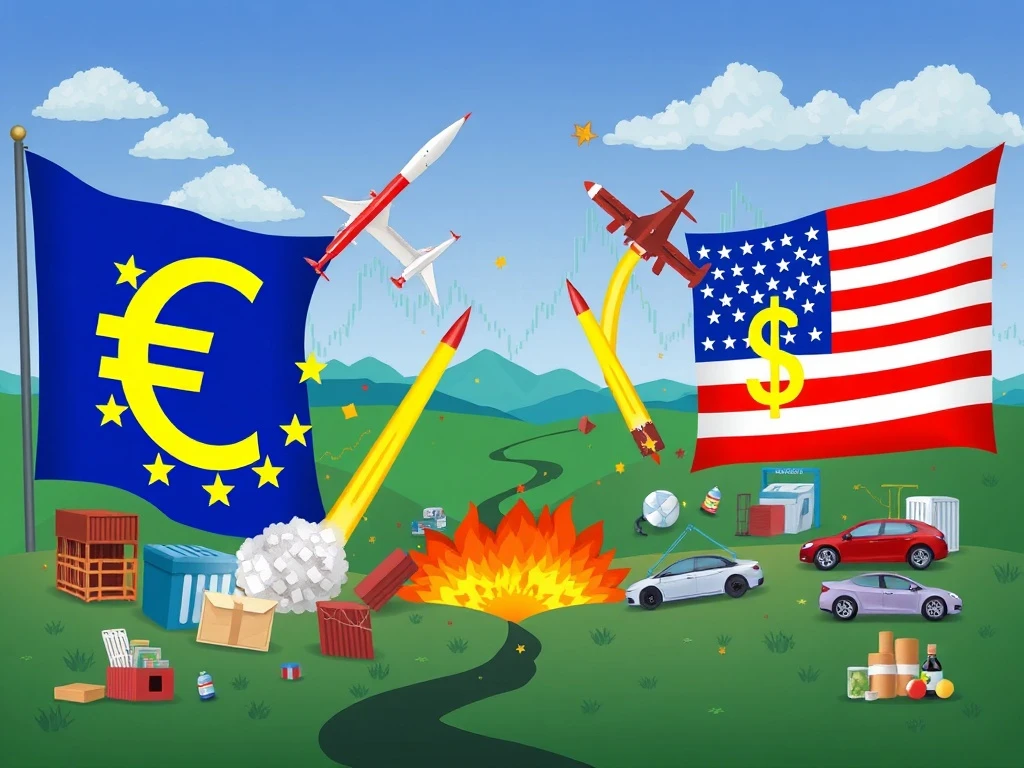EU Tariffs: Colossal €93 Billion Retaliation Jolts US Trade Stability

While the crypto market often dances to its own beat, it’s undeniably influenced by the broader currents of global economic stability. Today, we’re witnessing a significant ripple in those waters as the European Union greenlights a colossal €93 billion retaliatory tariff package against the United States. This isn’t just about tariffs; it’s a stark reminder that macroeconomic shifts, like escalating trade tensions, can create waves that eventually reach every corner of the financial world, including digital assets. Understanding these geopolitical chess moves is crucial for anyone navigating the complex global landscape.
What Are These EU Tariffs All About?
The European Union has given the nod to an unprecedented €93 billion retaliatory tariff package, directly targeting a wide array of US exports. This bold move is a direct response to Washington’s looming threat of 30% tariffs on European goods, set to commence on August 1st. The EU’s measure is slated to become effective on August 7th, unless a last-minute diplomatic breakthrough can avert the economic clash.
This comprehensive package isn’t a single, monolithic action. Instead, it’s structured in two distinct phases:
- Initial Response: A €21 billion tranche designed to deliver an immediate impact.
- Secondary Round: A more substantial €72 billion phase, intended to amplify pressure if the dispute remains unresolved.
The strategic intent behind these EU tariffs is clear: to counter what the bloc perceives as “unfair trade practices” by the United States. It’s a calculated signal of the EU’s readiness to absorb significant economic risks in order to safeguard its internal market and assert its economic sovereignty.
Why Are Trade Tensions Reaching a Boiling Point?
The current escalation in trade tensions between the EU and the US isn’t an isolated incident; it’s the culmination of prolonged and often fractious negotiations. For years, both economic giants have been locked in disputes over a range of contentious issues.
Key unresolved points that have fueled this tariff standoff include:
- Steel and Aluminum Duties: The US previously imposed tariffs on steel and aluminum imports from the EU, citing national security concerns, which the EU viewed as unjustified.
- Aerospace Subsidies: Long-standing disagreements over state subsidies provided to aerospace giants like Boeing (US) and Airbus (EU) have been a persistent source of friction, leading to tit-for-tat retaliations.
- Digital Tax Policies: Efforts by European nations to implement digital services taxes on large tech companies, many of which are US-based, have also drawn Washington’s ire, with threats of retaliatory tariffs.
The failure to find common ground on these critical issues has pushed the relationship to a breaking point. Unlike past instances where retaliatory measures were often symbolic, the EU’s current coordinated action demonstrates a strategic shift. It highlights a determination to leverage its industrial strengths, particularly in sectors like aviation with Airbus, to assert its economic leverage and protect its interests. The fact that the bloc initially considered an even larger €100 billion retaliation plan before scaling it back underscores the gravity of the situation and the careful calculation behind these moves.
Which US Exports Are In the Crosshairs?
The EU’s retaliatory tariffs are not randomly applied; they are strategically aimed at specific sectors and products designed to maximize impact on the US economy and exert diplomatic pressure. The targeted US exports are diverse, reflecting a broad approach to disrupt American supply chains and create economic discomfort.
Among the key targets identified in the EU’s tariff lists are:
- Aviation Industry: Boeing aircraft are a primary target. This directly challenges a major American industry and aligns with the ongoing aerospace subsidy dispute, where the EU’s Airbus stands as a formidable competitor.
- Agriculture Sector: American soybeans are notably included. This targets a significant US agricultural export, potentially impacting farmers in key political states.
- Automotive Industries: While specific details are not fully public, the automotive sector is broadly mentioned, indicating potential tariffs on US-made vehicles or auto parts. This could affect major US car manufacturers and their global supply chains.
- Luxury Goods: Interestingly, the list extends to high-value consumer items such as pearls and even condoms, showcasing a granular approach to imposing economic costs across various segments of the US economy.
This comprehensive targeting strategy is designed to send a clear message: the EU is prepared to inflict economic pain across multiple vital American industries if the trade disputes are not resolved.
Beyond Retaliatory Tariffs: The Anti-Coercion Card
Perhaps one of the most significant and novel aspects of the EU’s current strategy is the potential activation of its “anti-coercion” instrument. This tool, originally conceived and designed for disputes primarily involving China, represents a significant escalation in the EU’s diplomatic and economic arsenal.
The anti-coercion instrument could enable the EU to implement measures far beyond traditional retaliatory tariffs, including:
- Blocking Access to Public Procurement Markets: This would prevent US companies from bidding on lucrative public contracts within the EU, potentially impacting a wide range of industries from infrastructure to technology.
- Freezing Investments: The mechanism could allow the EU to freeze or restrict US investments within the bloc, creating significant hurdles for American businesses operating or planning to expand in Europe.
The very mention and potential use of such a powerful instrument underscore a hardening stance from Brussels towards Washington. It signals a readiness to escalate beyond conventional trade measures, aligning with broader global shifts towards sovereignty-driven policies and a re-evaluation of international trade alliances. This move indicates that the EU is not just reacting to threats but proactively building mechanisms to defend its economic interests in an increasingly fragmented global landscape.
What Does This Mean for Global Trade?
The authorization of these massive EU tariffs carries profound implications for global trade stability and economic relations. Analysts are warning that this aggressive move could significantly destabilize transatlantic trade, which has historically been one of the world’s largest and most robust economic partnerships.
Potential impacts on consumers and businesses are considerable:
- Increased Costs: Tariffs are essentially taxes on imported goods. These costs are often passed on to consumers, leading to higher prices for a wide range of products reliant on cross-border flows.
- Supply Chain Disruptions: Businesses in sectors heavily reliant on trade between the EU and US, such as aviation and automotive, face significant disruptions. Companies may need to re-evaluate their sourcing and production strategies, potentially leading to inefficiencies and delays.
- Market Volatility: The uncertainty surrounding these tariffs and the potential for further escalation can introduce significant volatility into global markets, impacting investor confidence and financial planning.
- Renewed Competition: In sectors like aviation, where Airbus and Boeing are direct competitors, these tariffs could intensify competition, potentially leading to shifts in market share and further price wars.
While diplomatic efforts remain active, with EU officials reportedly seeking last-minute negotiations, the absence of significant breakthroughs suggests a fragile situation. The outcome hinges on whether the US administration softens its demands or if the EU adjusts its position. The €93 billion threshold represents a clear marker of the EU’s resolve, reflecting both a calculated economic strategy and a significant geopolitical posture in an era of shifting alliances and rising protectionist pressures.
The EU’s decision to authorize €93 billion in retaliatory tariffs marks a critical juncture in transatlantic relations. Far from a symbolic gesture, this move is a robust assertion of economic sovereignty, designed to push back against perceived unfair trade practices from the United States. While diplomatic channels remain open, the imminent implementation of these tariffs threatens to reshape global trade dynamics, impacting industries from aviation to agriculture, and potentially raising costs for consumers worldwide. As the world grapples with an increasingly fragmented economic landscape, this escalation serves as a potent reminder of the interconnectedness of global markets and the far-reaching consequences of trade disputes. The ripple effects will undoubtedly be felt across various sectors, including potentially influencing the broader financial sentiment that underpins even the crypto markets.
Frequently Asked Questions (FAQs)
1. What is the primary reason for the EU’s €93 billion tariffs on US exports?
The EU is imposing these retaliatory tariffs in response to threatened 30% US tariffs on European goods and ongoing disputes over steel/aluminum duties, aerospace subsidies, and digital tax policies, which the EU considers unfair trade practices.
2. Which US sectors are specifically targeted by these EU tariffs?
The tariffs are strategically aimed at key US sectors including aviation (e.g., Boeing aircraft), agriculture (e.g., American soybeans), and automotive industries, along with some luxury goods.
3. When are these new EU tariffs expected to take effect?
The tariffs are authorized to become effective on August 7, 2025, unless a last-minute resolution is reached between the EU and the US.
4. What is the “anti-coercion” instrument mentioned in the EU’s strategy?
The anti-coercion instrument is a novel tool designed to allow the EU to escalate beyond traditional tariffs. It could enable the EU to block US access to public procurement markets or freeze investments within the bloc, signaling a tougher stance on trade disputes.
5. How might these trade tensions impact global markets and consumers?
These escalating trade tensions could destabilize transatlantic trade, leading to increased costs for consumers (as tariffs are passed on), disruptions in global supply chains, and potential volatility in financial markets across various sectors, including aviation and automotive.
6. Are there ongoing diplomatic efforts to prevent the implementation of these tariffs?
Yes, diplomatic efforts are active, with EU officials reportedly seeking last-minute negotiations to avoid the implementation of the tariffs. However, significant breakthroughs have not yet occurred, making the situation fragile.








